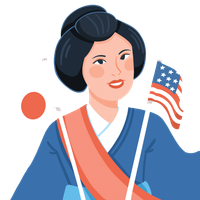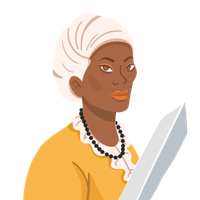happy international women's day 2025!
Thank you for purchasing our cupcake set!
Behind the silhouettes of the women on your cupcakes, are stories of women who defied expectations, broke barriers, and paved the way for future generations. From scientists to revolutionaries, activists to artists, these figures may not always be the most well-known, but their impact is undeniable.
As you enjoy your treats, we hope you take a moment to read about their journeys, their struggles, and their triumphs.
Let their stories inspire and remind us all of the strength, resilience, and brilliance of women throughout history.

Nguyễn Thị Định
(Vietnam, 1920 - 1992)
Born on March 15, 1920, in Bến Tre province, Nguyễn Thị Định was not only Vietnam’s first female vice president but also the first in the region.
Her revolutionary journey began at 16 with tasks such as communication, distributing leaflets, and mobilizing the masses. By 1946, she led a delegation to the North to report on the southern revolution and request arms to resist the French. That same year, she successfully captained a boat carrying 12 tonnes of weapons back to the South, evading enemy patrols—an achievement that later influenced the creation of the Ho Chi Minh Trail at sea.
She quickly rose through the ranks, leading the "Long-Haired Army", a movement that mobilized women in the fight against U.S. and South Vietnamese forces. In 1965, she became Deputy Commander of the National Liberation Front and President of the Union of Women for the Liberation of the South.
After Vietnam’s reunification, Nguyễn Thị Định held several key positions within the Party and State before serving as Vice President from 1987 to 1992.
Her unwavering strength and dedication to women’s rights not only cemented her legacy as a revolutionary leader but also proved the power of women in shaping history. Nguyễn Thị Định’s story is a testament to resilience, courage, and the vital role women play in the fight for justice and progress—something we continue to celebrate today.

Komako Kimura
(Japan, 1887–1980)
An actress, dancer, and theatre manager, Komaka Kimura was a pioneering Japanese suffragist who co-founded The True New Women’s Association in 1912, advocating for women’s rights in education, employment, and suffrage. The organization also sought to raise awareness about public health issues, including preventing men with venereal diseases from marrying.
As editor of Shin Shin Fujin magazine, Kimura tackled radical topics for the time, but the publication was shut down by the Japanese government in 1918. Facing further suppression, she defied bans on public meetings and lectures by making her theatre’s performances free, leading to her arrest. Her highly publicized trial inadvertently amplified her message.
In 1917, she traveled to the United States to improve her English and learn from the American suffrage movement. That same year, she was famously photographed at a New York suffrage march, proudly holding both the Japanese and American flags—a striking symbol of her international fight for women’s rights.

Nanny of The Maroons
(Jamaica, 1686–1733)
Nanny of the Maroons, also known as Queen Nanny or Granny Nanny, is a revered figure in Jamaican history, celebrated for her leadership in the resistance against British colonial rule.
Due to the time period in which she lived, much of her story has been passed down through oral tradition, leading to various accounts of her origins.
One widely accepted narrative suggests she was born around 1686 in present-day Ghana and brought to Jamaica via the transatlantic slave trade. Regardless of the details, one fact remains undisputed—her extraordinary bravery and strategic brilliance in leading guerrilla campaigns against British forces.
As enslaved Africans escaped into Jamaica’s mountainous interior, they joined Maroon settlements, using the dense forests and rugged terrain to evade capture. By the 18th century, the Maroons had divided into two main groups: the Windward Maroons, led by Nanny and Quao in the east, and the Leeward Maroons in the west.
Nanny’s leadership was marked by her deep understanding of guerrilla warfare. She and her warriors used their knowledge of the land to stage ambushes, disrupt British forces, and free over 1,000 enslaved Africans. She also wielded psychological warfare, creating an aura of invincibility through expert camouflage and stealth tactics. Despite their superior numbers, British troops suffered heavy losses in attempts to capture Nanny Town in the Blue Mountains.
Unable to suppress the Maroon resistance, the British ultimately negotiated a treaty with the Windward Maroons, granting them official recognition as free people and 500 acres of land in Portland Parish. While Nanny was initially reluctant to make peace with the colonizers, her leadership not only shaped the treaty but also played a role in the broader fight for emancipation, which culminated in the abolition of slavery in the British Empire in 1833.
Today, Nanny of the Maroons is a Jamaican national hero, honored on the country’s $500 bill. Her legacy stands as a powerful testament to resilience, strategic brilliance, and the enduring strength of women in the fight for freedom.

Chien-Shiung Wu
(China, 1912–1997)
Chien Shiung Wu was a Chinese-American physicist who has been dubbed “Queen of Nuclear Research” in the late 1900s.
Born in Jiangsu province near Shanghai in 1912, where she attended a school started by her father. Despite it being uncommon for girls to attend school during that time, Wu excelled and went on to university to study physics where one of her professors had worked with Marie Curie.
In 1936, she enrolled in University of California, Berkeley where she completed her Ph.D before moving on to teach in Smith College and Princeton University.
Her most renowned contributions includes her research contributions on the Manhattan Project - a top-secret World War II program to develop the first atomic bomb. In 1956, she led the groundbreaking Wu Experiment, which disproved a fundamental law of physics, yet her male colleagues received the Nobel Prize for the discovery. Despite this, her achievements earned her prestigious awards, including the Comstock Prize, the National Medal of Science, and the Wolf Prize in Physics.
Beyond her highly awarded professional success, Wu welcomed a son in, Vincent Wei-Cheng Yuan in 1947, who would then go on to follow in her footsteps to be a nuclear scientist.
visit us!
Opening hours
Daily 8:00 AM — 6:00 PM
